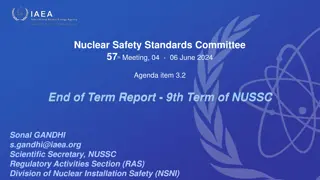ACAS Improvements for Enhanced Airborne Safety
Module N.B0-101 focuses on improving existing Airborne Collision Avoidance Systems (ACAS) to reduce nuisance alerts without compromising safety levels. It introduces several optional enhancements to minimize unnecessary alerts and improve overall safety during airborne operations. The module aims to implement improved ACAS operations through TCAS version 7.1, which brings significant safety and operational benefits. These enhancements are crucial for maintaining safety in cases where there is a breakdown of separation, ultimately increasing efficiency and safety in en-route and approach flight phases. The module also outlines necessary procedures for both air and ground operations related to ACAS.
Download Presentation

Please find below an Image/Link to download the presentation.
The content on the website is provided AS IS for your information and personal use only. It may not be sold, licensed, or shared on other websites without obtaining consent from the author. Download presentation by click this link. If you encounter any issues during the download, it is possible that the publisher has removed the file from their server.
E N D
Presentation Transcript
International Civil Aviation Organization SIP/ASBU/2012-WP/24F Aviation System Block Upgrades Module N B0-101/PIA-3 ACAS Improvements Workshop on preparations for ANConf/12 ASBU methodology (Bangkok, 14-18/Nadi, 21-25 May 2012)
Module N B0-101 ACAS Improvements Summary To provide short term improvements to existing airborne collision avoidance systems (ACAS) to reduce nuisance alerts while maintaining existing levels of safety. This will reduce trajectory perturbation and increase safety in cases where there is a breakdown of separation. KPA-04 Efficiency, KPA-10 Safety En-route flight phases and approach flight phases. Safety and operational benefits increase with the proportion of equipped aircraft. CM Conflict Management. GPI-2 reduced vertical separation minima Main Performance Impact Domain / Flight Phases Applicability Considerations Global Concept Component(s) Global Plan Initiatives () GPI-9 situational awareness GPI-16 Decision support systems and alerting systems Pre-Requisites Global Readiness Checklist No Status (ready now or estimated date) Standards Readiness Avionics Availability Ground Systems Availability Procedures Available Operations Approvals N/A ICAO SIP 2012- ASBU WORKSHOP 2
Module N B0-101 - Baseline ACAS is subject to global mandatory carriage for aeroplanes with a MTCM greater than 5.7 tons. The current version of ACASII is 7.0. ICAO SIP 2012- ASBU WORKSHOP 3
Module N B0-101 Change Brought by the Module Implements several optional improvements to airborne collision avoidance system in order to minimize nuisance alerts while maintaining existing levels of safety. Element Improved ACAS operations TCAS version 7.1 introduces significant safety and operational benefits for ACAS operations. Agreed to mandate the improved ACAS (TCAS version 7.1) for new installations as of 1/1/2014 and for all installations no later than 1/1/2017. ICAO SIP 2012- ASBU WORKSHOP 4
Module N B0-101 Intended Performance Operational Improvement Efficiency ACAS improvement will reduce unnecessary RA and then reduce trajectory perturbation Safety ACAS increase safety, as collision avoidance system and case of failure of the separation provision. CBA TBD ICAO SIP 2012- ASBU WORKSHOP 5
Module N B0-101 Necessary Procedures (Air & Ground) ACAS procedures are defined in PANS-ATM (Doc 4444) and in PANS-OPS (Doc 8168) ICAO SIP 2012- ASBU WORKSHOP 6
Module N B0-101 Necessary System Capability Avionics RTCA DO185B / EUROCAE DO143 MOPS are available for TCAS implementation. RTCA DO325 Annex C is being modified to accommodate the 2 functions (APFD and TCAP). It should be ready by Q1 2013. Ground Systems Not Applicable ICAO SIP 2012- ASBU WORKSHOP 7
Module N B0-101 Training and Qualification Requirements Training in the operational standards and procedures are required Likewise, the qualifications requirements are identified in the regulatory requirements Training guidelines are described in the ACAS Manual (Doc 9863). Recurrent training is recommended. Likewise, the qualifications requirements are identified in the regulatory requirements ICAO SIP 2012- ASBU WORKSHOP 8
Module N B0-101 Regulatory/standardization needs and Approval Plan (Air & Ground) Regulatory/Standardization: Use current published requirements Approval Plans: Must be in accordance with application requirements e.g. EASA NPA 2010-03 requirement of 1/3/2012 for new installations and 1/12/2015 for all installations, or ICAO mandate of 1/1/2014 for new installations and 1/1/2017 for all installations. ICAO SIP 2012- ASBU WORKSHOP 9
Module N B0-101 Reference Documents Standards ICAO Annex 6 Operation of Aircraft, Part I - International Commercial Air Transport Aeroplanes. carriage requirements; ICAO Annex 10 . Aeronautical Telecommunications, Volume IV - Surveillance Radar and Collision Avoidance Systems;. (Including Amendment 85- July 2010) EUROCAE ED-143 / RTCA DO-185B, Minimum Operational Performance Standards for Traffic Alert and Collision Avoidance System II (TCAS II); RTCA DO-325, Minimum Operational Performance Standards (MOPS) for Automatic Flight Guidance and Control Systems and Equipment. Appendix C estimated 2013 RTCA DO185B / EUROCAE DO143 MOPS for TCAS implementation. Procedures ICAO Doc 4444, Procedures for Air Navigation Services - Air Traffic Management; ICAO Doc 8168, OPS Aircraft Operations, Volume I Flight Procedures. Guidance Material ICAO Doc 9863, Airborne Collision Avoidance System (ACAS) Manual. Approval Documents FAA TSO-C119c; EASA ETSO-C119c; FAA AC120-55C; FAA AC20-151a; RTCA DO-185B, MOPS for TCAS II; RTCA DO-325, Appendix C, for APFD and TCAP; EUROCAE ED-143, MOPS for TCAS II. ICAO SIP 2012- ASBU WORKSHOP 10
Module N B0-101 Implementation - Benefits and Elements ACAS Improvements Benefits: Efficiency and Safety Element: Avionics: ACAS II (TCAS version 7.1) To be reflected in ANRF ICAO SIP 2012- ASBU WORKSHOP 11























